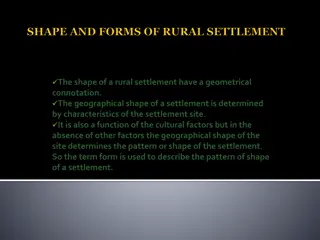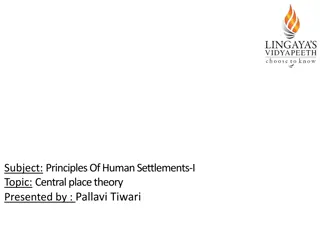Understanding Size and Spacing of Rural Settlements in Geography Research
This presentation delves into the significant influence of size and spacing on the distribution pattern of rural settlements. It explores how factors like population size, areal size, topography, soil fertility, and more impact the density and distribution of settlements, categorizing them based on population size. The discussion highlights the varying characteristics of very small, small, medium, and big villages, shedding light on the interplay between geographical factors and settlement patterns in rural areas.
Download Presentation

Please find below an Image/Link to download the presentation.
The content on the website is provided AS IS for your information and personal use only. It may not be sold, licensed, or shared on other websites without obtaining consent from the author. Download presentation by click this link. If you encounter any issues during the download, it is possible that the publisher has removed the file from their server.
E N D
Presentation Transcript
II M.SC. APPLIED GEOGRAPHY TITLE : POPULATION AND SETTLEMENT GEOGRAPHY DATE : 31.08.2020 TOPIC : SIZE AND SPACING OF RURAL SETTLEMENTS PRESENTED BY S. MAHESWARI, GUEST LECTURER IN GEOGRAPHY, GCW(A)K
SIZE AND SPACING OF RURAL SETTLEMENTS The distribution pattern of settlements are significantly influenced by their size and spacing. Generally, small settlements or villages are located at smaller distance and big centres have relatively longer distance apart. Areas which are densely populated due to fertile soils, plain land, availability of various resources like irrigation, transport etc. villages are much in number lying at smaller distance from each other. Otherwise, in uneven and unproductive or less productive areas, density of population is very low and resultant number of villages is few denoting low village density. Here an attempt is made to describe the facts relating to the size and spacing of rural settlements.
SIZE OF RURAL SETTLEMENT The village size is one of the main determinants of the density and distributional pattern of rural settlements. The size of rural settlement is depend on two important ways. They are. 1. Areal Size, and 2. Population Size. These are the main factors of the distribution patterns of rural settlements.
I. AREAL SIZE The Areal size is known as occupied area by the settlement. The areal size of rural settlements are greatly influenced by the following: 1. Topography, 2. Soil fertility, 3. Facility of irrigation, 4. Land tenure system, 5. Agricultural system, 6. Productivity, 7. Transport facilities and 8. Other geographical factors.
Areal size means total area lying under the boundary of revenue village. Average areal size of villages of a region can be following the formula : Average areal size of village = R P / N Where, R P = Total rural area of the region, N = Total number of villages.
II. POPULATION SIZE Population size denotes the number of people inhabiting in the settlement. The current definition states that census rural is the population outside settlements with fewer than 1000 inhabitants and population density below 400 people per square kms. According to this population size, categories: 1. Very small village, 2. Small villages, 3. Medium villages, and 4. Big villages. its classified the following
SPACING OF RURAL SETTLEMENTS INTRODUCTION: In the study of distribution pattern of settlements, the spacing or distance between them has much importance. According to Mukerjee (1969) the covariance of spacing of rural settlements depends on fundamental factors such as fertility of land productivity of agriculture, nature of crops grown, agronomic characteristics, distribution and availability of water, density of rural population, population size and types of rural settlements, mode of living, history and stages of land occupancy, relative strengths of tribal population and several other factors .
In the study of human settlements, spacing is termed as extension of areal size, therefore spacing of villages belong to relative locational arrangements of them. It is an important base for analysis of distributional pattern of villages in the district. Donglass, The spacing of rural settlement depend on three important factors, i.e., the agricultural prosperity, surface relief of land and historical perspectives of the area. In the study of spacing of rural settlements, by geographers, following three method have been commonly used: 1. Relative Spacing of Village, 2. Village Density, and 3. Dispersion of Rural Settlements.
I. RELATIVE SPACING OF VILLAGES The areal analysis of rural settlements denotes their relative locational arrangement and is inseparable inter-related to areal extent. The relative or average distance between two settlements depends upon the density of settlements in an area. To measure the distributional pattern of settlement in any region, Mather s formula commonly known as hypothetical distance method is given the below : D = 1.0746 A/N Where, D = Relative Spacing, A = Total area of the region, and N = Total number of inhabited village in the region. 1.0746 = Constant
C.E. Mather had applied this formula for the calculation of spacing between farmstead im the United States of America in 1944. Spacing of rural settlement belongs to relative locational arrangement of villages. It is an important base for analysis of distributional pattern of villages in a region. The spacing between two settlemens is generally derived by nearest neighbour analysis method. This method was introduced by Swainson in 1935 and followed by Barnes and Robinson and Mather with simple modifications. This type method commonly dividing the four main types for given below : 1. Low Spacing Regions, 2. Medium Spacing Regions, 3. High Spacing Regions, and 4. Very High Spacing Regions.
II. VILLAGE DENSITY Density of villages or rural settlements is one of the closely interwoven attributes of their spatial patterns. Its relates the distribution of rural settlements to the expansion of total rural area of the region. The density of villages tends to decrease with the increasing distance as well as size of villages. This may be judged on the basis of area and population both. Following formula is used to calculate the village density : D = N/A 100 Where, D = Village Density, A = Total rural area of the region, N = Total number of villages in the region.
III. DISPERSION OF RURAL SETTLEMENTS For the analysis of spacing and dispersion of rural settlements, nearest neighbour method, introduced by J.P. Clark and F.C.Evance in 1954 is favourite method. Applying this method, nearest neighbour ratio (Rn ratio) is calculated for a particular region which indicates the distribution pattern of the settlements. Obtaining this index, ot is attempted to know that distribution pattern of rural settlements in region is clustered or random or regular.
Rn ratio may be calculated from the formula given below : Rn = Do / De Do = Do De = 0.5 A/N Where, Rn = Nearest Neighbour Ratio Do = Average of observed nearest neighbour distances De = Average of expected nearest neighbour distances A = Total area of the region N = Total number of settlements.
This statistical test compares observed point patterns against theoretically derived random patterns. The average of the distances between each observed point and its nearest neighbour is divided by the expected random spacing to obtain nearest neighbour ratio. Rn values range from 0 to 2.149. Rn value 0 indicates complete clustered distribution, 1.0 presents random distribution and 2.15 is the indication of uniform or grid distribution. The use of Rn index is in describing, not explaining, a point pattern (Maurya, S.D., 2011).























